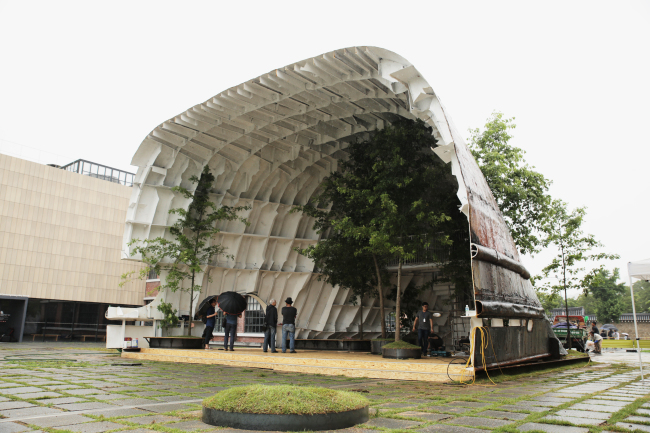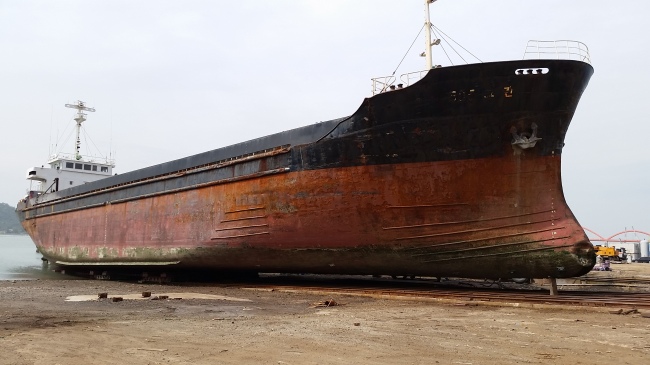A retired cargo ship that operated between Mokpo and Jejudo Island for 35 years has become an architecture installation that serves as a summertime shelter in the courtyard of the National Museum of Modern and Contemporary Art, Korea.
The installation “Temp’L” by Shinslab Architecture, led by architect duo Shin Hyung-chul and Claire Shin, is the winning design project of this year’s Young Architects Program.
The Korean edition of the program, launched by the Museum of Modern Art in New York in 1998, has annually selected winning architecture designs since 2014. These are then installed in the museum courtyard.
“It felt like a treasure hunt (finding the retired ship),” said Shin Hyung-chul, at the press preview of the exhibition on Tuesday.
He traveled to Pakistan, Bangladesh, India and China to find retired ships, but transporting them to Korea proved problematic. Then he found a ship that was about to be dismantled in the southwestern port city of Mokpo.
“I discovered aesthetics on its rusty surface and scars and in the colors created from more than 20 layers of paint that covered the ship. I realized that an industrial object can become a work of art,” he said.
 |
"Temp’L” by Shinslab Architecture on display in the courtyard of the MMCA in Seoul (Shinslab Architecture/MMCA) |
The architects dismantled the 60-ton discarded cargo ship and added architectural inspirations from Marcel Duchamp’s iconic toilet and Le Corbusier’s “An Eye that Cannot See” image featured in his book “Towards an Architecture.” More concepts and ideas that Shin borrowed from modern architecture are on view at Gallery 8 along with model works by finalists of the Young Architects Program.
“Temp’L commences with an analysis. Artists and architects tested boundaries of modernism including Marcel Duchamp, and in so doing, reconfigured these pieces of our daily life that we overlook and disregard, including environmental issues,” said Sean Anderson, the associate curator of architecture at MoMA in New York City who was one of the jurors of the YAP.
Shin likened the redesigned ship to the toilet “Fountain” that Duchamp designated as art and displayed in a museum exhibition in 1917, breaking the centuries-old notion that artworks should be handmade by artists.
“The work is noted with two popular concepts in contemporary art and architecture – presenting objects themselves as art and recycling materials,” said Park Geun-tae, the curator of the project.
Acclaimed French architect Le Corbusier greatly influenced Shin in coming up with his plan to transform the ship into an installation.
“A photograph of major landmarks in Paris are lined with their shadows forming the shape of a huge ocean liner. He titled it ‘an eye that cannot see,’” Shin explained. Le Corbusier presented the idea of finding beauty in industrial architecture such as ships and airplanes.
 |
A retired freighter that transported cargo between Mokpo and Jejudo Island for 35 years(Shinslab Architecture/MMCA) |
Shin turned the ship upside down and planted trees inside to create a garden. In contrast to the tough-looking exterior, the inside is painted in white and filled with green leaves, an ideal resting spot for passers-by and museum visitors. He also installed several holes to allow the breeze to enter from outside.
“Le Corbusier said ‘Architecture is a machine for living.’ I think architecture should be alive,” Shin said.
The exhibition runs until Oct. 3 in the courtyard and the Gallery 8 of the MMCA.
For more information, visit
www.mmca.go.kr.
By Lee Woo-young (
wylee@heraldcorp.com)









